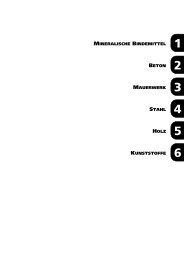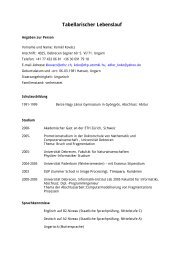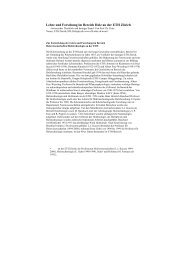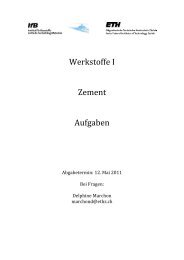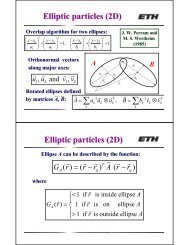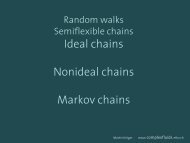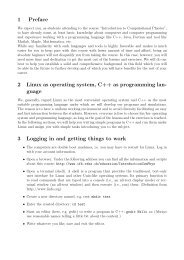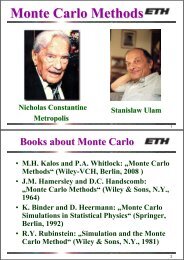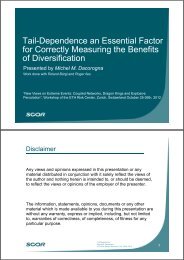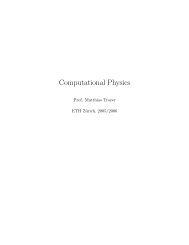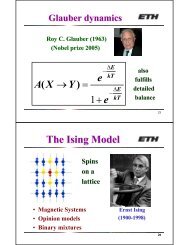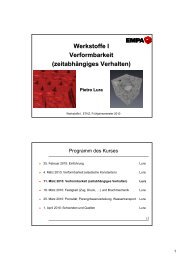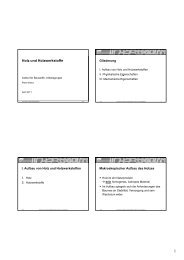A MESOSCOPIC MODEL FOR C-S-H HYDRATION AND SETTINGKaterina Ioannidou 1 , Emanuela Del Gado 11 <strong>ETH</strong> Zürich, Zürich, Switzerland.INTRODUCTION: Calcium-silicate-hydrate (C-S-H) is the primary hydration product of Portlandcement. It precipitates and solidifies into a nanoscalegel, which literally glues together thedifferent parts of cement and it is responsible <strong>for</strong>its mechanics [1-4]. To investigate the connectionbetween the evolution of the C-S-H gelmicrostructure and its rheological properties [5],we use a mesoscale model, whose fundamentalunits are nano-scale particles. Although thisapproach does not account <strong>for</strong> the atomistic detailsof the C-S-H these ultimately determine thecohesive effective interaction of the nano-particles[6]. We follow the nano-particles trajectories withMolecular Dynamics. A very important effect inthe evolution of the C-S-H gel is the continuoushydration reaction. To incorporate in our modelthe <strong>for</strong>mation of new C-S-H hydrates, weintroduce Monte Carlo events of addition anddeletion [7]. The competition between effectiveinteractions and particle <strong>for</strong>mation allowscooperative motions and rearrangements, whichlead to complex spatial configurations andrheological behavior.DISCUSSION & RESULTS: We present thesimulation results <strong>for</strong> two different interactionpotentials that would correspond to different limeconcentrations. We analyze the aggregationprocess <strong>for</strong> different precipitation parameters thatproduce different non-equilibrium structures anddynamics. Analyzing the trajectories of the MDsimulations, we characterize the microscopicstructure and dynamics of the gels in terms of theradial distribution function, the structure factor,the mean square displacement and theintermediate scattering function. Per<strong>for</strong>ming shearde<strong>for</strong>mation tests by means of non-equilibriumMD, we observe different solid-like behaviorsarising during far from equilibrium aggregation.Fig. 1: Microstructures of the mesoscale gelmodel <strong>for</strong> C-S-H, at density ρ=0.25 andtemperature T=0.3, <strong>for</strong> two different effectiveinteractions in equilibrium.REFERENCES:[1] A.J. Allen, J. J. Thomas, H.M. Jennings, Nat.Mater. 6, 311-316 (2007).[2] J.W. Bullard, H.M. Jennings, R.A. Livingston,A. Nonat, G.W. Scherer, J.S. Schweitzer, K.L.Scrivener, J.J. Thomas, Cem. and Concr. Res., 41,1208-1223 (2010).[3] C.Vernet, G. Cadoret, Les B.H.P.,charactéristiques, durabilité, applications,E.N.P.C. Press, Paris (1992). [4] A. Nonat, Cem. and Concr. Res., 34, 1521-1528 (2004).[5] D. Lootens, P. Hébraud, E. Lécolier, H. VanDamme, Oil Gas Sci. Tech. 59, 31-40 (2004).[6] R.J.-M. Pellenq, A. Kushima, R. Shahsavari,K.J. Van Vliet, M.J. Buehler, S. Yip, F.-J. Ulm,PNAS 106, 16102-16107 (2009).[7] E. Masoero, E. Del Gado, R.J. Pellenq, F.J.Ulm and S. Yip, "Nano-structure and –mechanicsof cement: Polydisperse colloidal packing",preprint (2012).58
1 H Nuclear Magnetic Resonance Pulsed Field Gradient Diffusometry Analysis ofWhite Cement PastesV. Rodin, S.Zamani, P.J. McDonaldDepartment of Physics, University of Surrey, Guild<strong>for</strong>d, Surrey, GU2 7XH, UK.INTRODUCTION: We report1 H nuclearmagnetic resonance (NMR) pulsed field gradient(PFG) diffusometry measurements to the study ofwater dynamics and microstructure in whitecement pastes. These new experiments, whichextend previous work 1 , are made and interpreted inthe light of recent advances in the understanding ofporosity arising from 1 H NMR relaxation timeanalysis.M<strong>ETH</strong>ODS: PFG diffusometry is a wellestablishedmethod <strong>for</strong> measuring the selfdiffusioncoefficient of small molecules in liquids.A short pulse of magnetic field gradient, g, ofduration δ is used to encode the spatial location ofmolecules through a rotational phase angle. A shorttime Δ later a second pulse of gradient applied inthe opposite sense is used to unwind this rotation.Any residual rotational phase is a direct measure ofmolecular displacement. Measurements are madeas a function of g, δ or Δ. Averaging over allmolecules in bulk liquid the measurement canyield the self diffusion coefficient D.In porous media, the molecular motion isrestricted. Hence, measurements of the apparentdiffusion coefficient as a function of g or δ and Δcan reveal in<strong>for</strong>mation on the pore morphology.Hence, the alternate name <strong>for</strong> the method, NMR q-space microscopy 2 .Cements pose multiple challenges. First, the largemagnetic field gradient due to inhomogeneity ofmagnetic susceptibility can swamp appliedgradients making quantitative measurementdifficult. Second, cements have small pores so thatmean free paths are very limited. Thirdly, NMRrelaxation times are very short, limiting themaximum values of δ and Δ that can be applied.However, there are known routes to overcomingsome of these limitations 3 .RESULTS: The self-diffusion coefficientmeasured with a short Δ decreases rapidly duringthe early stages of hydration. Moreover, the waterfraction exhibiting this diffusion coefficientdecreases too. This is in line with relaxation timemeasurements that show increasing fractions ofwater either chemically bound into the structure orrestricted to increasingly confined poreenvironments.In more mature samples, the primary signal arisesfrom the small fraction of residual capillary water.We explore the Δ dependence of the diffusionencoded signal as a function of the gradientstrength. We show that, <strong>for</strong> accessible Δ up toabout 50 ms, the encoding is in the medium to longtime limit, whereby the molecules sample thewhole pore space during the measurement. Weanalyse the data in terms of different models ofrestricted diffusion and infer capillary pore sizes ofthe order of microns. This is larger than measuredby relaxometry. However, it is likely that as Δincreases and only accesses the more slowlyrelaxing molecules, so the experiment self-selects adiminishing reservoir fraction of larger pore sizeswithin the overall pore size distribution since poresize correlates with signal relaxation times T 1 andT 2 .log (I/I0)1.000.100.010 0.05 0.1 0.15β 2 ( rads/ µ m)2Fig. 1: Normalised echo intensity as a function ofβ 2 = (γδg) 2 /5, <strong>for</strong> a 54-day old white cement pastew/c=0.4. Δ=6 ms, where γ is the gyromagneticratio of 1 H . The solid line is the fit to the longtime limit model 2 and yields a pore size of 7.2 ±2.8 µm.REFERENCES:1 N. Nestle, P. Galvosas and J. Karger, Cem. Conc. Res.,37, 398-413, (2007).2 P. T. Callaghan, Translational Dynamics andMagnetic Resonance (Ox<strong>for</strong>d University Press, 2011).3 R. Kimmich, NMR - Tomography, Diffusometry,Relaxometry (Springer, 1997), Germany.ACKNOWLEDGEMENTS: The authors wouldlike to thank U.K. Engineering and Physical SciencesResearch Council <strong>for</strong> financial support. (Grantnumber EP/H033343)59



